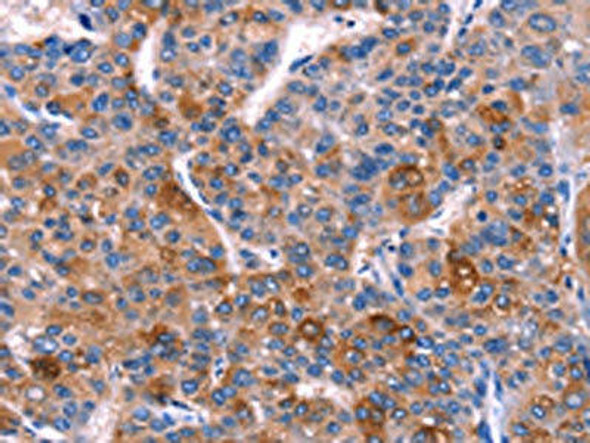Description
DUSP13 Antibody (PACO63507)
The DUSP13 Polyclonal Antibody (PAC063507) is a valuable tool for researchers studying the DUSP13 protein, a member of the dual specificity phosphatase family involved in regulating cell signaling pathways. This rabbit-raised antibody is highly specific to human samples and has been validated for use in Western blot applications. By targeting the DUSP13 protein, this antibody allows for the detection and analysis of DUSP13 expression in a variety of cell types, making it an ideal choice for studies in signal transduction and cancer biology.DUSP13, also known as dual-specificity phosphatase 13, plays a crucial role in regulating the activity of key signaling molecules within the cell, impacting processes such as cell growth, differentiation, and apoptosis.
Dysregulation of DUSP13 has been implicated in various diseases, including cancer and neurological disorders, highlighting its importance as a potential therapeutic target. By gaining a better understanding of the function of DUSP13, researchers can uncover new insights into disease mechanisms and potentially develop novel treatment approaches.
| Antibody Name: | DUSP13 Antibody (PACO63507) |
| Antibody SKU: | PACO63507 |
| Size: | 50ul |
| Host Species: | Rabbit |
| Tested Applications: | ELISA, IHC |
| Recommended Dilutions: | ELISA:1:2000-1:10000, IHC:1:20-1:200 |
| Species Reactivity: | Human |
| Immunogen: | Recombinant Human Dual specificity protein phosphatase 13 isoform B protein (1-198AA) |
| Form: | Liquid |
| Storage Buffer: | Preservative: 0.03% Proclin 300 Constituents: 50% Glycerol, 0.01M PBS, pH 7.4 |
| Purification Method: | Antigen Affinity Purified |
| Clonality: | Polyclonal |
| Isotype: | IgG |
| Conjugate: | Non-conjugated |
 | IHC image of PACO63507 diluted at 1:100 and staining in paraffin-embedded human colon cancer performed on a Leica BondTM system. After dewaxing and hydration, antigen retrieval was mediated by high pressure in a citrate buffer (pH 6.0). Section was blocked with 10% normal goat serum 30min at RT. Then primary antibody (1% BSA) was incubated at 4°C overnight. The primary is detected by a biotinylated secondary antibody and visualized using an HRP conjugated SP system. |
| Background: | Dual specificity phosphatase that dephosphorylates MAPK8/JNK and MAPK14/p38, but not MAPK1/ERK2, in vitro. Exhibits intrinsic phosphatase activity towards both phospho-seryl/threonyl and -tyrosyl residues, with similar specific activities in vitro. |
| Synonyms: | Dual specificity protein phosphatase 13 isoform B (DUSP13B) (EC 3.1.3.16) (EC 3.1.3.48) (Dual specificity phosphatase SKRP4) (Testis- and skeletal-muscle-specific DSP), DUSP13, DUSP13B TMDP |
| UniProt Protein Function: | DUSP13: May be involved in the regulation of meiosis and/or differentiation of testicular germ cells during spermatogenesis. Exhibits intrinsic phosphatase activity towards both phospho- seryl/threonyl and -tyrosyl residues of myelin basic protein, with similar specific activities in vitro. Belongs to the protein-tyrosine phosphatase family. Non-receptor class dual specificity subfamily. 5 isoforms of the human protein are produced by alternative promoter. |
| UniProt Protein Details: | Protein type:EC 3.1.3.16; Motility/polarity/chemotaxis; Protein phosphatase, dual-specificity; Cell cycle regulation; EC 3.1.3.48 Chromosomal Location of Human Ortholog: 10q22.2 Cellular Component: cytoplasm Molecular Function:protein tyrosine/serine/threonine phosphatase activity; protein tyrosine phosphatase activity Biological Process: meiosis; spermatogenesis; protein amino acid dephosphorylation |
| NCBI Summary: | Members of the protein-tyrosine phosphatase superfamily cooperate with protein kinases to regulate cell proliferation and differentiation. This superfamily is separated into two families based on the substrate that is dephosphorylated. One family, the dual specificity phosphatases (DSPs) acts on both phosphotyrosine and phosphoserine/threonine residues. This gene encodes different but related DSP proteins through the use of non-overlapping open reading frames, alternate splicing, and presumed different transcription promoters. Expression of the distinct proteins from this gene has been found to be tissue specific and the proteins may be involved in postnatal development of specific tissues. A protein encoded by the upstream ORF was found in skeletal muscle, whereas the encoded protein from the downstream ORF was found only in testis. In mouse, a similar pattern of expression was found. Multiple alternatively spliced transcript variants were described, but the full-length sequence of only some were determined. [provided by RefSeq, Jul 2008] |
| UniProt Code: | Q9UII6 |
| NCBI GenInfo Identifier: | 257051044 |
| NCBI Gene ID: | 51207 |
| NCBI Accession: | Q9UII6.3 |
| UniProt Secondary Accession: | Q9UII6,Q5JSC6, Q6IAR0, Q96GC2, A8K776, A8K782, B3KPY1 B3KXT0, B4DUK0, |
| UniProt Related Accession: | Q6B8I1,Q9UII6 |
| Molecular Weight: | 198 |
| NCBI Full Name: | Dual specificity protein phosphatase 13 isoform B |
| NCBI Synonym Full Names: | dual specificity phosphatase 13 |
| NCBI Official Symbol: | DUSP13 |
| NCBI Official Synonym Symbols: | BEDP; MDSP; TMDP; SKRP4; DUSP13A; DUSP13B |
| NCBI Protein Information: | dual specificity protein phosphatase 13; muscle-restricted DSP; branching-enzyme interacting DSP; testis- and skeletal-muscle-specific DSP; branching-enzyme interacting dual-specificity protein phosphatase |
| UniProt Protein Name: | Dual specificity protein phosphatase 13 isoform B |
| UniProt Synonym Protein Names: | Dual specificity phosphatase SKRP4; Testis- and skeletal-muscle-specific DSP |
| Protein Family: | Dual specificity protein phosphatase |
| UniProt Gene Name: | DUSP13 |
| UniProt Entry Name: | DS13B_HUMAN |













